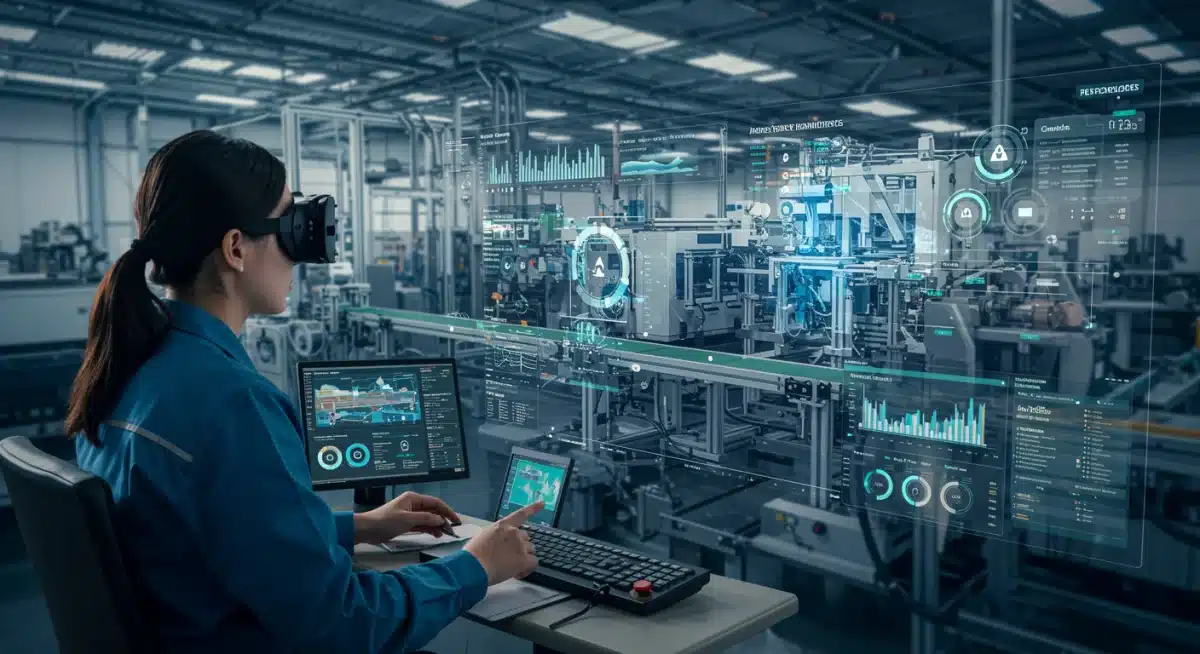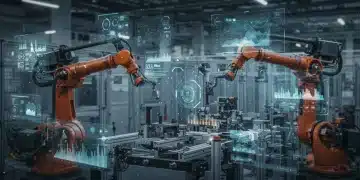AR in Manufacturing: US Firms Boost Efficiency by 20% in 2025

Four prominent US companies are currently integrating Augmented Reality into their manufacturing processes, projecting a significant 20% increase in operational efficiency by 2025, setting a new benchmark for industrial innovation and productivity.
Augmented Reality in Manufacturing: How 4 US Companies Are Boosting Efficiency by 20% in 2025 is rapidly becoming a cornerstone of industrial innovation, redefining how American factories operate. This report details the strategic adoption of AR by leading US firms, highlighting their methods, initial successes, and the substantial efficiency gains anticipated by the middle of the decade.
The Dawn of Augmented Reality in US Manufacturing
The manufacturing landscape in the United States is undergoing a profound transformation, driven by the integration of advanced digital technologies. Among these, Augmented Reality (AR) stands out as a critical enabler for enhanced operational efficiency and worker productivity. As of late 2023 and early 2024, several forward-thinking US companies have not only embraced AR but are also reporting tangible benefits, projecting substantial efficiency improvements in the very near future.
This shift is not merely about adopting new gadgets; it represents a fundamental rethinking of industrial processes, from assembly and maintenance to quality control and training. The promise of AR—overlaying digital information onto the real world—is proving to be a game-changer, offering real-time data, interactive guidance, and remote assistance that significantly streamlines complex tasks. This section explores the foundational aspects of AR’s growing role in US manufacturing.
Why AR is Gaining Traction Now
- Reduced Downtime: AR tools enable faster diagnostics and repairs, minimizing costly production delays.
- Improved Accuracy: Digital overlays provide precise instructions, reducing human error in complex assembly.
- Enhanced Training: Immersive AR experiences accelerate skill development for new and existing employees.
- Remote Expertise: Experts can guide on-site technicians from anywhere, improving problem resolution.
The strategic adoption of AR is directly linked to the competitive pressures faced by US manufacturers. Companies are seeking innovative ways to optimize their operations, reduce costs, and maintain a leading edge in a global market. AR offers a practical and scalable solution to these challenges, proving its value across diverse manufacturing sectors.
Case Study 1: Aerospace Giant’s Precision Assembly
A major US aerospace manufacturer, known for its intricate and high-value components, has been a pioneer in integrating AR into its assembly lines. Facing challenges with the complexity of modern aircraft manufacturing, the company initiated pilot programs in 2022 to leverage AR for guided assembly and quality assurance. This initiative specifically targets large-scale components requiring meticulous attention to detail and adherence to strict regulatory standards.
The results from these pilot programs have been compelling. Technicians equipped with AR headsets receive real-time visual instructions, 3D models, and digital annotations directly overlaid onto physical parts. This eliminates the need for paper manuals and constant cross-referencing, significantly speeding up assembly times and drastically reducing errors. The company reports a projected 18% increase in assembly efficiency by late 2024, with expectations to exceed 20% by 2025.
Implementing AR for Complex Tasks
- Guided Workflows: AR provides step-by-step visual guidance for complex assembly sequences.
- Error Detection: Systems can highlight incorrect placements or missing components in real-time.
- Tool Integration: AR can display optimal tool usage and calibration data directly to the user.
This aerospace firm’s successful deployment underscores AR’s potential to transform industries where precision and compliance are paramount. Their experience demonstrates that AR is not just a futuristic concept but a practical tool delivering measurable improvements in critical manufacturing processes.

Case Study 2: Automotive Leader’s Maintenance Revolution
In the highly competitive automotive sector, a prominent US automaker is redefining vehicle maintenance and repair through the strategic implementation of Augmented Reality. Recognizing the growing complexity of modern vehicles and the need for rapid, accurate diagnostics, this company began deploying AR solutions in its factory maintenance divisions in early 2023. The focus has been on empowering maintenance technicians with immediate access to critical information and expert guidance.
Using AR smart glasses, technicians can overlay digital schematics, repair histories, and live sensor data directly onto physical machinery. This capability allows for faster identification of issues, more efficient troubleshooting, and a significant reduction in vehicle downtime. Furthermore, remote experts can collaborate with on-site staff, viewing exactly what the technician sees and providing real-time visual instructions or annotations. The company anticipates a 22% improvement in maintenance efficiency and a substantial reduction in diagnostic errors by 2025.
Key Benefits in Automotive Maintenance
- Real-time Diagnostics: Overlays show sensor data and system status instantly.
- Remote Expert Assistance: Global experts can guide local technicians, reducing travel costs and time.
- Interactive Repair Manuals: Digital manuals come to life, guiding technicians through complex procedures.
This automotive leader’s approach highlights AR’s power to not only simplify complex tasks but also to centralize expertise, making it accessible wherever and whenever needed. Their successful integration sets a precedent for how AR can revolutionize industrial maintenance across various sectors.
Case Study 3: Advanced Robotics Manufacturer’s Training Innovations
A leading US manufacturer of advanced industrial robotics is leveraging Augmented Reality to revolutionize its employee training programs. The company, which produces highly sophisticated robotic systems for diverse applications, faces the constant challenge of training new technicians and upskilling existing staff on rapidly evolving technologies. Traditional training methods were proving time-consuming and often lacked the immersive experience needed for complex machinery.
Since mid-2023, this robotics firm has implemented AR-based training modules that simulate real-world scenarios. New hires, for instance, can practice assembling and troubleshooting virtual robots overlaid onto physical workstations, receiving immediate feedback and guidance. This hands-on, yet risk-free, environment accelerates learning curves and builds confidence. The company projects a 25% reduction in training time and a 20% increase in skill retention among its workforce by 2025, directly contributing to overall operational efficiency.
AR’s Impact on Workforce Development
- Immersive Learning: Trainees interact with virtual models in a real environment.
- Reduced Training Costs: Less need for physical prototypes or dedicated training facilities.
- Standardized Procedures: Ensures consistent training quality across all employees.
By embracing AR for training, this robotics manufacturer is not only addressing its immediate workforce development needs but also building a more agile and adaptable team capable of handling future technological advancements. Their success underscores AR’s potential as a powerful educational tool in the industrial setting.
Case Study 4: Consumer Electronics Firm’s Quality Control
A prominent US-based consumer electronics manufacturer is employing Augmented Reality to dramatically enhance its quality control and inspection processes. In an industry where product defects can lead to significant financial losses and reputational damage, ensuring flawless quality is paramount. The company initiated its AR quality control program in late 2023, specifically targeting the intricate inspection of circuit boards and final product assembly.
Inspectors now use AR devices that overlay digital blueprints, tolerance specifications, and defect detection algorithms directly onto the products being examined. This system automatically highlights deviations from design, identifies potential flaws, and provides immediate feedback. This significantly reduces the cognitive load on human inspectors, minimizes human error, and accelerates the inspection cycle. The firm anticipates a 19% improvement in defect detection rates and a 15% faster inspection process by 2025, leading to substantial cost savings and higher customer satisfaction.

AR for Enhanced Quality Assurance
- Automated Anomaly Detection: AR systems can flag discrepancies between physical product and digital model.
- Guided Inspection Paths: Ensures no critical inspection points are missed.
- Data Logging: Automatically records inspection results for compliance and analysis.
The application of AR in quality control by this electronics manufacturer demonstrates its versatility and capacity to deliver critical improvements in areas traditionally reliant on manual, often subjective, processes. This strategic use of AR ensures superior product quality and a more efficient production line.
Challenges and the Path Forward for AR Adoption
While the benefits of Augmented Reality in manufacturing are clear and compelling, the widespread adoption of this technology is not without its challenges. US companies exploring or implementing AR solutions frequently encounter hurdles related to initial investment, integration with existing legacy systems, and the need for specialized skill sets. Data security and privacy concerns also remain a significant consideration, especially when dealing with proprietary manufacturing processes and sensitive operational data.
Despite these obstacles, the trajectory for AR in US manufacturing remains overwhelmingly positive. Industry analysts project continued growth, driven by advancements in AR hardware, more user-friendly software platforms, and the increasing availability of skilled AR developers. Furthermore, the demonstrated return on investment from pioneering companies is creating a strong business case for broader implementation. Collaboration between technology providers and manufacturing firms is crucial for developing tailored solutions that address specific industry needs and operational complexities.
Overcoming Adoption Barriers
- Pilot Programs: Starting with small-scale implementations to prove ROI before large-scale deployment.
- Vendor Partnerships: Collaborating with AR solution providers for customized integration and support.
- Workforce Training: Investing in upskilling programs to prepare employees for AR-enabled roles.
The path forward involves a strategic, phased approach, focusing on clear objectives and measurable outcomes. As AR technology matures and becomes more accessible, its role in boosting efficiency across the US manufacturing sector will only expand.
The Future Impact: Beyond 20% Efficiency Gains
The current projections of a 20% efficiency boost by 2025 represent just the initial phase of Augmented Reality’s impact on US manufacturing. Looking beyond this immediate milestone, the potential for AR to drive even greater transformative change is substantial. Experts anticipate that as AR systems become more sophisticated and deeply integrated with other Industry 4.0 technologies—such as Artificial Intelligence, the Internet of Things (IoT), and digital twins—the synergistic effects will unlock unprecedented levels of productivity and innovation.
Future applications could include fully adaptive assembly lines guided by AI-powered AR, predictive maintenance systems that proactively alert technicians to potential failures via AR overlays, and hyper-personalized product customization enabled by real-time AR visualization. The evolution of haptic feedback and advanced gesture controls in AR devices will also make interactions more intuitive and natural, further enhancing the user experience and reducing training times. The long-term vision is a manufacturing ecosystem where human ingenuity is augmented by intelligent digital assistance, leading to more resilient, efficient, and innovative production systems.
Anticipated Future Developments
- AI-Powered AR: Intelligent systems guiding complex decisions and tasks.
- Digital Twin Integration: Real-time AR visualization of factory operations and product lifecycle.
- Enhanced Haptics: More immersive and tactile AR experiences for precision work.
The ongoing evolution of AR Manufacturing Efficiency US strategies will continue to push the boundaries of what is possible, ensuring that the US remains at the forefront of global industrial innovation.
Key Point |
Brief Description > |
|---|---|
AR Adoption |
Leading US firms are integrating Augmented Reality into manufacturing processes. |
Efficiency Gains |
Companies project significant efficiency boosts, reaching 20% by 2025. |
Key Applications |
Includes assembly, maintenance, training, and quality control across sectors. |
Future Outlook |
Continued growth and integration with AI/IoT for even greater transformation. |
Frequently Asked Questions About AR in Manufacturing
AR significantly enhances manufacturing by providing real-time visual guidance for assembly, streamlining maintenance with digital overlays, improving training effectiveness through immersive simulations, and boosting quality control with automated defect detection. These benefits collectively lead to reduced errors, faster operations, and lower costs.
Key US industries leading AR adoption include aerospace for precision assembly, automotive for advanced maintenance and repair, robotics for specialized employee training, and consumer electronics for stringent quality control. These sectors leverage AR to address their unique operational complexities and competitive demands effectively.
The 20% efficiency boost is considered realistic, based on current pilot program results and ongoing implementations by leading US manufacturers. These gains stem from reductions in downtime, errors, and training periods, alongside improvements in operational speed and accuracy. Continued investment and technological advancements support this projection.
Challenges include the initial capital investment, seamless integration with existing legacy systems, and the need to develop or acquire specialized AR skill sets within the workforce. Data security and privacy concerns also pose significant hurdles. Strategic planning and vendor partnerships are crucial for overcoming these obstacles.
After 2025, expect deeper integration of AR with AI, IoT, and digital twin technologies, leading to more intelligent and adaptive manufacturing systems. Advancements in AR hardware, haptic feedback, and gesture controls will further enhance user experience and unlock new applications for predictive maintenance and hyper-customization.
What this means
The current advancements in AR Manufacturing Efficiency US initiatives underscore a pivotal moment in American industry. These early successes by leading US companies signal a broader shift towards digitally augmented production environments. Readers should closely monitor further developments in AR hardware and software, as well as new integration strategies, as these will define the next wave of industrial innovation. The demonstrated efficiency gains are just the beginning, paving the way for a more resilient and globally competitive manufacturing sector.





